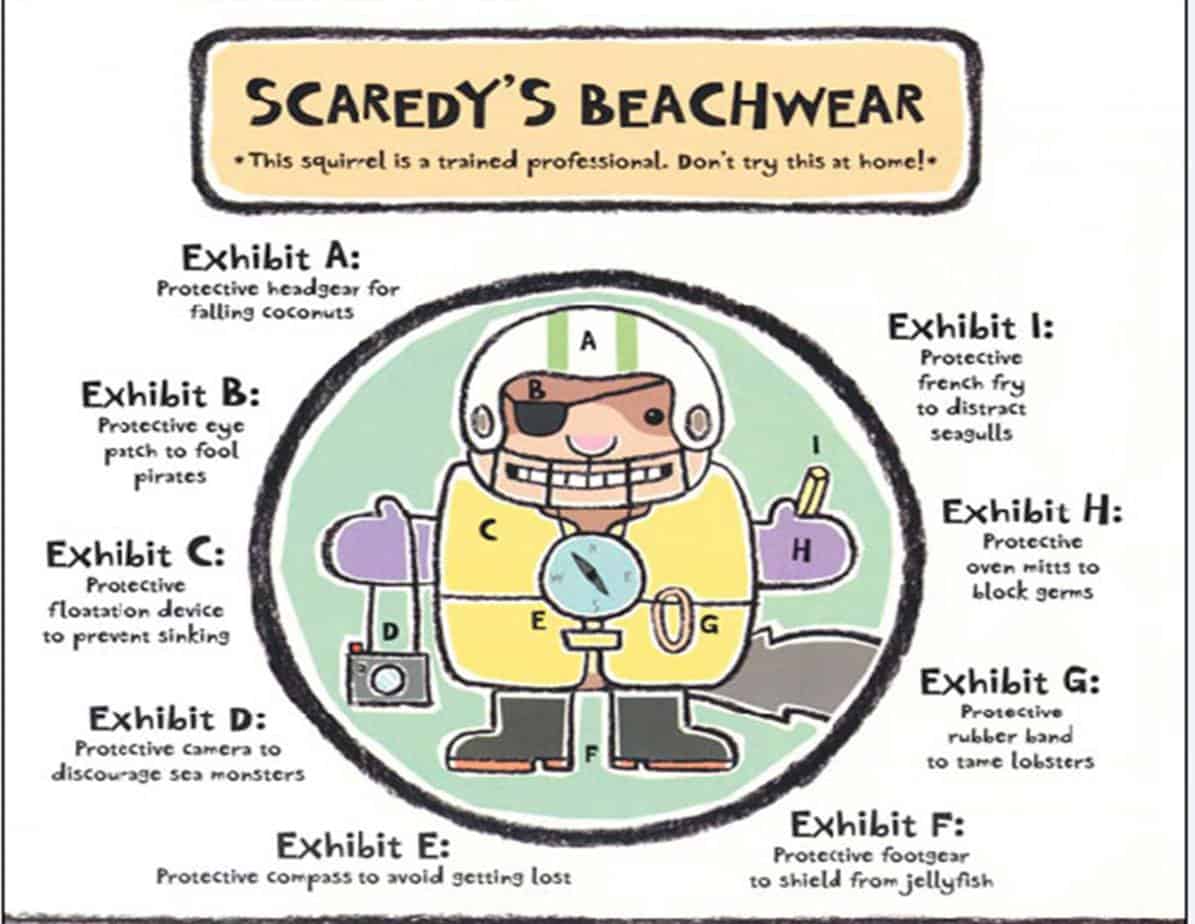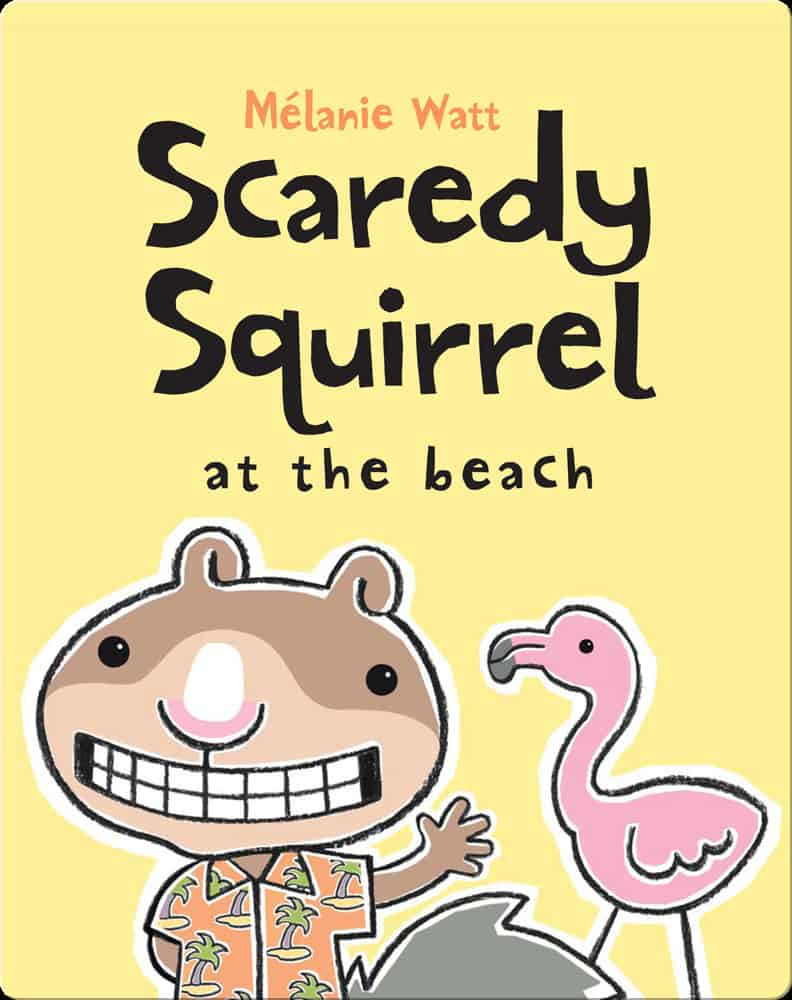Scaredy Squirrel At The Beach (2008), written and illustrated by Mélanie Watt, is the third picture book in a series starring an anxious squirrel who deals with his fears by facing them head on, though his exposure therapy is comically accidental.

SETTING OF SCAREDY SQUIRREL AT THE BEACH
The beach in storytelling is multivalent, and is used as the emotionally turbulent backdrop of romantic comedies (a la Nicholas Sparks), of Gothic horror (a la Jane Campion’s The Piano), and of straight horror (as seen across much Australian literature) The beach is also, of course, utilised across narrative as a straight utopia.
The archetypal picture book beach is utopic, but as this particular picture book shows, the beach can also feel scary. Unlike horror beach stories for adults, Scaredy Squirrel At The Beach shows young readers that the scary beach really is a utopia, if only you can learn to enjoy its pleasures.
STORY STRUCTURE OF SCAREDY SQUIRREL AT THE BEACH
NARRATION AND IRONY
There’s a layer of irony undergirding the entire story because of the ‘how-to’ narration. The words and images on the page read like an instruction manual. Typically (well, ideally), an instruction manual is the most dryly useful example of transaction writing we encounter in our lives, so it’s ripe for spoofing.
Also, when all of the text is ‘intratext’ (embedded into the pictures), it will help the emergent reader feel as if they are not reading at all. This is why I think these books would be good for the emergent reader as well as for the preschool aged audience.

PARATEXT
We know by now that Scaredy Squirrel only feels safe when he’s at home in his nut tree, with his defenses, his emergency kit and his back-up plans at the ready. So even though the sun is shining and it’s time for a vacation, Scaredy does not want to go to the beach — that vast, frightening place where a squirrel could get stranded. (Not to mention other hazards such as sea monsters, falling coconuts, seagulls, pirates and lobsters.)
Instead, Scaredy builds his own safe beach getaway under his nut tree, complete with germ-free inflatable pool, artificial beach scenery, a flashlight and a plastic flamingo.
Still, the lure of the genuine beach is strong — even a dedicated homebody such as Scaredy can’t resist it forever. Can his back-up plans save him from its perils? Will his No.65 sunscreen protect his delicate complexion?
MARKETING COPY
SHORTCOMING
Scaredy Squirrel is among the ten per cent of children who feel significant levels of anxiety, and this book is for them.
We might consider this story an allegory for agoraphobia, but it’s really not that. Genuine agoraphobia cannot be so easily resolved.
But Scaredy Squirrel is a comedic character as well as an anxious one. So the storyteller must give him a comedic shortcoming as well. Scaredy Squirrel is similar to two hit characters created by Mo Willems and his team: Elephant and Piggie. Elephant’s generalised anxiety is offset by Piggie’s exuberance; we might even consider them two aspects of the same character. Like Scaredy Squirrel, Elephant and Piggie set about creating play scenarios for themselves and, while fully immersed in their imaginative landscapes, they fail to see the bigger picture of the veridical world.
In Elephant and Piggie Go For A Drive, Elephant and Piggie make all sorts of preparations for a day trip, and forget that they don’t have a car. In Scaredy Squirrel At The Beach, Scaredy Squirrel worries about all sorts of unlikely events, and completely fails to predict what is obvious to any reader who has ever visited a beach: there will be people.
This in itself provides an extra layer of comedy for the adult co-reader, who will understand that most things we worry about are irrational.
DESIRE
Scaredy Squirrel would like a beach experience, but his anxiety is preventing him from visiting the seaside.
Next, he would like to recreate a beach experience at his own house, but he can’t hear the sound of the sea. This feels inauthentic, so his plans must change.
OPPONENT
It’s more difficult for storytellers to create a satisfying story for the reader when there’s no real character opposition. Difficult, but not impossible, as this story shows. Scaredy Squirrel’s biggest opponent is his own anxiety.
However, an imaginary Minotaur opponent is as effective for storytelling purposes as an actual Minotaur opponent, as many picture books show. The Minotaur opponents of Scaredy Squirrel’s vivid imagination are introduced early on, in a diagram of Scaredy Squirrel’s fears.
PLAN
Comical characters are often funny because, when faced with a problem, they make ridiculous or quirky plans to get themselves out of it. The audience knows these plans aren’t going to work, and we derive enjoyment from seeing stupid and quirky plans fail.
However, the comedy writer can’t simply set up a problem, show the comical character making a stupid plan and then failing at it, no matter how many quirky details are used. That isn’t enough to achieve a full gag. The plan has to fail in a way the audience did not fully expect.
THE BIG STRUGGLE
Scaredy Squirrel has failed to foresee crowds of people at the beach. He’s been too busy worrying about other kinds of crowds, as laid out in an early spread — crowds of dangerous and unlikely creatures. He’s been worried about a small creature in a seashell.
ANAGNORISIS
The opponents Scaredy Squirrel feared were not the opponents Scaredy Squirrel faced. He slowly comes to the realisation that the people around him are not going to hurt him. The reverse is true: A shadow looms above him, and a girl invites him to play. He realises he loves the real beach.
NEW SITUATION
The character arc in this picture book is comically massive. Scaredy Squirrel experiences a 180 degree turnaround: Rather than fear crowds, he now craves them. At home in his yard, making use of his miniature beach set-up, he surrounds himself with garden gnomes. Not just one or two, mind you, but a whole heap of them. Here the storyteller makes use of visual hyperbole for comic effect.
EXTRAPOLATED ENDING
Because this is a series, we know that Scaredy Squirrel faces each specific fear one book at a time. His newfound experiences won’t really help to lower his overall anxiety levels, because the stories require that he start in a place of extreme anxiety.
He seems to have made a new permanent friend, as well, because he has inadvertently picked up a seashell with a creature living inside and brought it home.
RESONANCE
Honestly, this seashell detail feels more like something out of a 1980s/90s picture book. Many contemporary picture books encourage an environmental message about leaving the natural world intact, even at the micro level of children visiting a natural space and leaving things there, no matter how desirable they seem.
It will be interesting to see how picture books continue to deal with/avoid the realworld effects of climate crisis.
SQUIRREL HORROR


